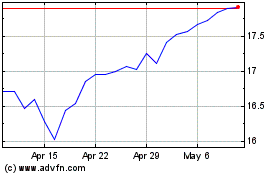California could face shut-offs for decade
By Katherine Blunt
This article is being republished as part of our daily
reproduction of WSJ.com articles that also appeared in the U.S.
print edition of The Wall Street Journal (October 19, 2019).
PG&E Corp.'s chief executive said Friday that it could take
as long as 10 years for the company to improve its electric system
enough to significantly diminish the need to pull the plug on
customers to reduce the risk of sparking fires.
Bill Johnson, who joined the company in May, made the disclosure
at a California Public Utilities Commission hearing where the
panel's president, Marybel Batjer, sharply criticized the company's
"inadequate execution" of a shut-off in which it turned off power
to large portions of Northern California for more than two days
last week.
The commission convened an emergency meeting to examine
PG&E's handling of the massive blackout, which left roughly two
million people in the dark and created widespread havoc from the
Bay Area to the northern reaches of the state. Several of the
company's top executives were summoned to detail the problems and
take questions from regulators.
"I can tell you that you guys failed on so many levels on fairly
simple stuff," Ms. Batjer said.
The agency earlier this week ordered PG&E to address
numerous problems with its strategy for such blackouts, known as
public safety power shut-offs. It condemned the company's failure
to provide maps and other critical information to residents and
local officials ahead of the shut-off. PG&E's website crashed
for two days during the blackout, and its call centers were
overwhelmed.
Mr. Johnson on Friday apologized for the hardships caused by the
shut-off but defended the company's decision to implement it,
noting that none of its power lines sparked fires, even though
strong winds in certain areas caused damage to its system.
"Making the right decision on safety is not the same as
executing that decision well," he said. "PG&E has to be better
prepared than it was this time."
PG&E, which provides gas and electricity to 16 million
people, shut off the power to more than 700,000 homes and
businesses in anticipation of strong winds that could have
increased the chances of its power lines sparking fires. The
company's equipment has sparked 19 major fires during windy periods
in 2017 and 2018, mostly because vegetation blew into live
wires.
PG&E isn't the only California utility to deploy shut-offs
to mitigate wildfire risks. Edison International's Southern
California Edison and Sempra Energy's San Diego Gas & Electric
also cut power recently in response to windy conditions. But
PG&E is the only U.S. utility to have initiated a
weather-related blackout on such a large scale.
The decision drew the ire of legislators and local officials who
have called on PG&E to act more prudently in enacting future
shut-offs. A group of Northern California governments, including
Napa and Sonoma counties, on Thursday filed a scathing brief with
the utilities commission that berated PG&E for its lack of
preparedness.
"The experience of working with PG&E to effect real changes
to its de-energization program has been like battling the Hydra,"
it read. "This has got to stop."
For now, the shut-offs will continue as PG&E scrambles to
trim trees near power lines and upgrade equipment across its
70,000-square-mile service territory, after a protracted drought
this decade turned millions of acres of forest into a
tinderbox.
Another major fire tied to PG&E's equipment would likely
drive the company to insolvency. It sought bankruptcy protection in
January, citing more than $30 billion in liability costs stemming
from the 2017 and 2018 fires, which collectively killed more than
100 people.
At the meeting Friday, commissioners questioned the company's
commitment to its customers and how long it anticipates deploying
its shut-off strategy on such a large scale.
Mr. Johnson said the utility is working to limit the scope of
future shut-offs by trimming more trees and installing technology
to enable the shutdown of smaller, more targeted portions of the
grid. But he estimated it will take as long as a decade before its
shut-offs will have "ratcheted down significantly."
"I think they'll decrease in size and scope every year," he
said. "But at the same time we're doing this the risk is not
static, it's dynamic and it goes up every year."
Already, PG&E is behind on several of its most important
safety efforts, records show, including this year's tree-trimming
campaign, which is less than 50% complete. It also trails its peers
in technology to track winds and isolate the areas where equipment
is at highest risk of sparking fires.
Though the company warned of continued shut-offs, it is working
to limit their duration.
Michael Lewis, PG&E's senior vice president of electric
operations, said the company, which previously advised customers to
prepare for shut-offs lasting as long as five days, will work to
restore power within 48 hours after initiating a shut-off.
"We now recognize that five days as a benchmark is
unacceptable," he said.
Write to Katherine Blunt at Katherine.Blunt@wsj.com
(END) Dow Jones Newswires
October 19, 2019 02:47 ET (06:47 GMT)
Copyright (c) 2019 Dow Jones & Company, Inc.
PG&E (NYSE:PCG)
Historical Stock Chart
From Mar 2024 to Apr 2024

PG&E (NYSE:PCG)
Historical Stock Chart
From Apr 2023 to Apr 2024
